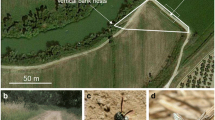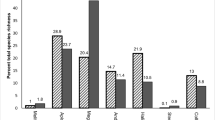Abstract
Most nests of brood-caring insects are colonized by a rich community of mite species. Since these nests are ephemeral and scattered in space, phoresy is the principal mode of dispersal in mites specializing on insect nests. Often the mites will arrive on the nest-founding insect, reproduce in the nest and their offspring will disperse on the insect's offspring. A literature review shows that mites reproducing in the underground brood chambers of burying beetles use alternative routes for dispersal. For example, the phoretic instars of Poecilochirus spp. (Mesostigmata: Parasitidae) disperse early by attaching to the parent beetles. Outside the brood chamber, the mites switch host at carcasses and pheromone-emitting male beetles, where juvenile and mature burying beetles of several species congregate. Because they preferably switch to beetles that are reproductively active and use all species of burying beetles within their ranges, they have a good chance of arriving in a new brood chamber. Other mite associates of burying beetles (Alliphis necrophilus and Uropodina) disperse from the brood chamber on the beetle offspring. We suggest that these mites forgo the possible time gain of dispersing early on the parent beetles because their mode of attachment precludes host switching. Their phoretic instars, once attached, have to stay on their host and so only dispersing on the beetle offspring guarantees that they are present on reproducing burying beetles of the next season. The mites associated with burying beetles providean example of multiple solutions to one life history problem – how to find a new brood chamber for reproduction. Mites that have mobile phoretic instars disperse on the parent beetles and try to arrive in the next brood chamber by host switching. They are independent of the generation cycle of a single host and several generations of mites per host generation are possible. Mites that are constrained by their mode of attachment disperse on the beetle offspring and wait until their host becomes mature and reproduces. By doing this they synchronize their generation time with the generation time of their host species. Exp Appl Acarol 22: 621–631 © 1998 Kluwer Academic Publishers
Similar content being viewed by others
REFERENCES
Ambros, M. 1995. Milben an Kleinsäugern in Österreich. Berichte des naturwissenschaftlichmedizinischen Vereins Innsbruck 82: 111-119.
Athias-Binche, F., Schwarz, H.H. and Meierhofer, I. 1993. Phoretic association of Neoseius novus(Ouds., 1902) (Acari: Uropodina) with Nicrophorusspp. (Coleoptera: Silphidae): a case of sympatric speciation? Int. J. Acarol. 19: 75-86.
Baker, A.S. and Schwarz, H.H. 1997. Morphological differences between sympatric populations of the Poecilochirus carabicomplex (Acari: Mesostigmata: Parasitidae) associated with burying beetles (Silphidae: Nicrophorus). Systematic Parasitology 37: 179-185.
Beninger, C.W. 1993. Egg predation by Poecilochirus carabi(Mesostigmata: Parasitidae) and its effects on reproduction of Nicrophorus vespilloides(Coleoptera: Silphidae). Environ. Entomol. 22: 766-769.
Brown, J.M. and Wilson, D.S. 1992. Local specialization of phoretic mites on sympatric carrion beetle hosts. Ecology 73: 463-478.
Brown, J.M. and Wilson, D.S. 1994. Poecilochirus carabi: behavioral and life-history adaptations to different hosts and the consequences of geographical shifts in host communities. In Mites: ecological and evolutionary analyses of life-history patterns, M.A. Houck (ed.), pp. 1-22. Chapman & Hall, New York.
Christie, J.E. 1981. Mites associated with British burying beetles (Coleoptera, Silphidae). PhD thesis, University of Leeds.
Christie, J.E. 1983. A new species of Alliphis(Mesostigmata: Eviphididae) from Britain. Acarologia 24: 231-242.
Clayton, D.H. and Tompkins, D.M. 1994. Ectoparasite virulence is linked to mode of transmission. Proc. R. Soc. London B 256: 211-217.
Costa, M. 1969. The association between mesostigmatic mites and coprid beetles. Acarologia 11: 411-428.
Eggert, A.-K. 1992. Alternative male mate-finding tactics in burying beetles. Behav. Ecol. 3: 243-254.
Eggert, A.-K. and Müller, J.K. 1992. Joint breeding in female burying beetles. Behav. Ecol. Sociobiol. 31: 237-242.
Eickwort, G.C. 1990. Associations of mites with social insects. Ann. Rev. Entomol. 35: 469-488.
Eickwort, G.C. 1994. Evolution and life-history patterns of mites associated with bees. In Mites: ecological and evolutionary analyses of life-history patterns, M.A. Houch, pp. 218-251. Chapman & Hall, New York.
Ewald, P.W. 1983. Host-Parasite relations, vectors, and the evolution of disease severity. Ann. Rev. Ecol. System. 14: 465-485.
Faasch, H. 1967. Beitrag zur Biologie der einheimischen Uropodiden Uroobovella marginata(C. L. Koch 1839) und Uropoda orbicularis(O. F. Müller 1776) und experimentelle Analyse ihres Phoresieverhaltens. Zool. Jahrbücher System. 94: 521-608.
Haitlinger, R. 1976. Parasitological investigation of small mammals of Góry Sowie (Middle Sudetes). IV. Acarina (Mesostigmata). Polskie Pismo Entomol. 46: 771-821.
Haitlinger, R. 1990. Mites (Acari) ocurring on Geotrupes vernalis(L., 1758) (Insecta, Scarabaeidae) in Poland. Wladomosci Parazytol. 36: 137-143.
Houck, M.A. and O'Connor, B.M. 1991. Ecological and evolutionary significance of phoresy in the Astigmata. Ann. Rev. Entomol. 36: 611-636.
Hunter, P.E. and Rosario, R.M.T. 1988. Associations of Mesostigmata with other arthropods. Ann. Rev. Entomol. 33: 393-417.
Hyatt, K.H. 1980. Mites of the subfamily Parasitinae (Mesostigmata: Parasitidae) in the British Isles. Bull. Br. Museum Nat. History (Zool. Ser.) 38: 237-378.
Hyatt, K.H. 1990. Mites associated with terrestrial beetles in the British Isles. Entomol. Monthly Mag. 126: 133-147.
Hyatt, K.H. and Emberson, R.M. 1988. A review of the Macrochelidae (Acari: Mesostigmata) of the British Isles. Bull. Br. Museum Nat. History (Zool. Ser.) 54: 63-125.
Korn, W. 1982a. Beiträge zur postembryonalen Entwicklung von Poecilochirus carabiG. u. R. Canestrini 1882 und P. austroasiaticusVitzthum 1930 (Acarina, Gamasina). Jahrbücher der Coburger Landesstiftung 27: 239-266.
Korn, W. 1982b. Zur Fortpflanzung von Poecilochirus carabiG. u. R. Canestrini 1882 (syn. P. necrophoriVitzt.) und P. austroasiaticusVitzthum 1930 (Gamasina, Eugamasidae). Spixiana (Muench) 5: 261-288.
Korn, W. 1983. Zur Vergesellschaftung der Gamasidenarten Poecilochirus carabiG. u. R. Canestrini 1882 ( = P. necrophoriVitzthum 1930), P. austroasiaticusVitzthum 1930 und P. subterraneusMüller 1859 mit Aaskäfern aus der Familie der Silphidae. Spixiana (Muench) 6: 251-279.
Masan, P. 1994. The eviphidid mites (Acarina: Mesostigmata: Eviphididae) associated with scarabaeid and carrion beetles (Coleoptera: Scarabaeidae, Silphidae) in central Europe. Acarologia 35: 3-19.
Micherdzinski, W. 1969. Die Familie Parasitidae Oudemans 1901 (Acarina, Mesostigmata). Panstwowe Wydawnictwo Naukowe, Krakow.
Milne, L.J. and Milne, M. 1976. The social behavior of burying beetles. Sci. Am. 235 (2): 84-89.
Müller, J.K. and Eggert, A.-K. 1987. Effects of carrion-independent pheromone emission by male burying beetles (Silphidae: Necrophorus). Ethology 76: 297-304.
Olynyk, J.E. and Freitag, R. 1979. Some phoretic associations of ground beetles (Coleoptera: Carabidae) and mites (Acarina). Can. Entomol. 111: 333-335.
Peck, S.B. and Kaulbars, M.M. 1987. A synopsis of the distribution and bionomics of the carrion beetles (Coleoptera: Silphidae) of the conterminous United States. Proc. Entomol. Soc. Ontario 118: 47-81.
Pukowski, E. 1933. Ökologische Untersuchungen an NecrophorusF. Zeitschrift Morphol. Ökol. Tiere 27: 518-586.
Rohner, C. 1990. Nischentrennung und interspezifische Konkurrenz zwischen Totengräbern der Gattung Necrophorus(Coleoptera, Silphidae) im Zürichseegebiet. Rev. Suisse Zool. 97: 453-464.
Sakofski, F., Koeniger, N. and Fuchs, S. 1990. Seasonality of honey bee colony invasion by Varroa jacobsoniOud. Apidologie 21: 547-550.
Scheucher, R. 1957. Systematik und Ökologie der deutschen Anoetinen. In. Beiträge zur Systematik und Ökologie mitteleuropäischer Acarina, Vol. 1, Part 1, H.J. Stammer (ed.) pp. 233-384. Akademische Verlagsgesellschaft Geest & Portig, Leipzig.
Schwarz, H.H. 1992. Populationsökologische und verhaltensbiologische Untersuchungen an zwei Verhaltenstypen der Milbenart Poecilochirus carabi(Mesostigmata: Parasitidae): Anpassungen an die Biologie ihrer Wirte, die Aaskäfer der Gattung Nicrophorus(Coleoptera: Silphidae). PhD thesis, Universität Bielefeld.
Schwarz, H.H. 1996. Host range and behavioral preferences in German sibling species of the Poecilochirus carabicomplex (Acari: Mesostigmata: Parasitidae). Int. J. Acarol. 22: 135-140.
Schwatz, H.H. and Huck, K. 1997. Phoretic mites use flowers to transfer between foraging bumble bees. Insect: Soc. 44: 303-310.
Schwarz, H.H. and Müller, J.K. 1992. The dispersal behaviour of the phoretic mite Poecilochirus carabi(Mesostigmata, Parasitidae): adaptation to the breeding biology of its carrier Necrophorus vespilloides(Coleoptera, Silphidae). Oecologia 89: 487-493.
Schwarz, H.H. and Walzl, M.G. 1996. Pairing, oviposition and development in two sibling species of phoretic mites (Acari: Mesostigmata: Parasitidae: Poecilochirusspp.) associated with burying beetles (Coleoptera: Silphidae: Nicrophorusspp.). J. Nat. History 30: 1337-1348.
Schwarz, H.H., Starrach, M. and Koulianos, S. 1998. Host specificity and permanence of associations between mesostigmatic mites (Acari: Anactinotrichida) and burying beetles (Coleoptera: Silphidae: Nicrophorus). J. Nat. History 32: 159-172.
Sikes, D.S. 1996. The natural history of Nicrophorus nigrita, a western nearctic species (Coleoptera: Silphidae). Pan-Pacific Entomol. 72: 70-81.
Springett, B.P. 1968. Aspects of the relationship between burying beetles, Necrophorusspp. and the mite, Poecilochirus necrophoriVitz. J. Animal Ecol. 37: 417-424.
Starzyk, J.R. 1967. An interesting case of phoresis of the mite Poecilochirus necrophoriVitzh (Parasitiformes, Parasitidae) on the burying beetle Nicrophorus fossorEr. (Coleoptera, Silphidae). Przeglad Zool. 11: 51-53.
Takaku, G., Katakura, H. and Yoshida, N. 1994. Mesostigmatic mites (Acari) associated with ground, burying, roving carrion and dung beetles (Coleoptera) in Sapporo and Tomakomai, Hokkaido, Northern Japan. Zool. Sci. 11: 305-311.
Trumbo, S.T. 1990. Interference competition among burying beetles (Silphidae, Nicrophorus). Ecol. Entomol. 15: 347-355.
Trumbo, S.T. 1992. Monogamy to communal breeding: exploitation of a broad resource base by burying beetles (Nicrophorus). Ecol. Entomol. 17: 289-298.
Wilson, D.S. 1983. The effect of population structure on the evolution of mutualism: a field test involving burying beetles and their phoretic mites. Am. Nat. 121: 851-870.
Wilson, D.S. and Knollenberg, W.G. 1984. Food discrimination and ovarian development in burying beetles (Coleoptera: Silphidae: Nicrophorus). Ann. Entomol. Soc. Am. 77: 165-170.
Wilson, D.S. and Knollenberg, W.G. 1987. Adaptive indirect effects: the fitness of burying beetles with and without their phoretic mites. Evol. Ecol. 1: 134-159.
Author information
Authors and Affiliations
Rights and permissions
About this article
Cite this article
Schwarz, H.H., Koulianos, S. Review. When to leave the brood chamber? Routes of dispersal in mites associated with burying beetles. Exp Appl Acarol 22, 621–631 (1998). https://doi.org/10.1023/A:1006054604520
Issue Date:
DOI: https://doi.org/10.1023/A:1006054604520




